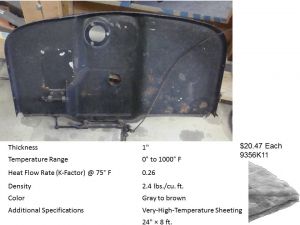- Home
- About Us
- Join/Renew
- Member Benefits
- Member Pages
- Log In
- Help
- Museum Store
Well, with a little help (really a lot of help) from my PA friends, I am starting to work on the body of my ’33 836 and wondered what color the firewall, engine side, is supposed to be. All the pictures I see seem to be black. Should it be Body color? flat black? chassis black? gloss??? If not body color, where are the boundaries.
Got it to roll and steer a couple of weekends ago for the first time in about 60 years. It had 3 In Law power, 2 sons and a brother. Rebuilt Worm drive seemed ok. It ain’t much to look at, but it is starting to function. Since I just passed the 5 year mark, I think I can see a way to the end.
This will be an interesting discussion. My ’31 phaeton was restored in 1960, then later by me. In the 1960 restoration, the then owner followed original colors and patterns to a fault. In doing so, the firewall was painted main body color.
I picture a body, waiting for a frame, in the paint shop at PAMCC. Would they really tape off the firewall and paint it black? My personal opinion is no, but again, the guys with original cars will chime in here…
I’ll say gloss black, same as the frame. Today’s gloss are about the same as the ones in the thirties. We made several comparisons over the years to cars that we removed the shocks off of and they were all gloss black. Now we will hear from others for sure……..Ed
I say body color.
But things may have changed from ’29 to ’33.
My very original ’29 is body color under the hood.
As far as I know the car has never been painted and it’s been in the family since the early 60’s.
Last fall I stripped all of the paint off my ’29 body; the repaint and the original paint and primer. I found that the firewall was painted black. I don’t know if it was gloss; but it looked like a semi gloss. Because time had taken its toll on the finish, but I would say it looked like chassis black like the frame.
Hi Bill,
The ’33 thru ’35 (and maybe other years) used a detachable engine side firewall (called a “sub-dash”), and a welded-in cabin side second firewall (dash), with about 1.5 inches of kapok insulation in between. The engine side sub-dash was attached by unpainted (cad or zinc) pan head machine screws to the cowl, with 9/64″ or 5/32″ diameter fender welting in between for squeak prevention (round bead showing). I have seen several original sub-dashes and all were semi-gloss black. It stands to reason: they would grab a black sub-dash and black welting for any car coming down the line. Tried to upload a photo, but didn’t work. Email me if you want one.
Cheers,
Bob
Bob,
Thanks for the response. Ok,I think I understand the sub dash. The info on the screws and the paint is great. Is the area around the sub dash body color on your car?
Bill
the area next to the fire wall panel is painted body color on my original paint cars
David,
Thank you, I would say you are a pretty good authority.
Bill
Bill, probably moot by now, but here is a picture of my fwd firewall from last year as well as some info on a fiberglass batt from McMaster-Carr I used to replace the Kapok in between the two firewalls. The Kapok wasn’t completely torn apart when I removed it and could have been pieced back together, but asked myself why? The original kapok may have been treated to make it fire resistant but pretty sure the fiberglass is probably better in that regard. This fiberglass is higher density than typical fiberglass insulation and seemed like a decent substitute. I also used it to form the thick batt that is squeezed into the pocket between the inside dash/firewall and the inside of the cowl.
Also helpful hint learned the hard way. Assemble the throttle cross shaft linkage back onto the front firewall before dropping the engine back in.
Jim

The firewall on my 1929 Roadster which has only 24000 miles is the body color.
Another hint: If you want to replace the interior insulating pad (visible from the cabin) on a ’33 – ’35 (maybe others), while you have the engine side firewall off, cut off the screws holding the interior pad, and install captive nuts in the holes in the welded firewall. The screws and nuts are usually rusted solid, so installing a new pad would be difficult to say the least. You can probably do it later, when you replace the pad, cutting the screws off and installing captive nuts, but easier when apart, cutting screws off at nut side.
Bob,
That is an invaluable piece of “Tribal” knowledge that I wouldn’t have thought of. Thanks for posting. Also, it is great to have a rear end that actually rolls.
Bill
